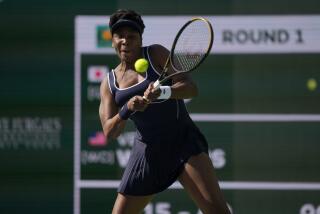WTA Trying to Learn From Its Nightmare
- Share via
So, what can the Women’s Tennis Assn. do to avoid a repeat of the Williams controversy at Indian Wells?
The short answer: Nothing.
If a player decides to pull out because of an injury five minutes before the start of a match, scheduled to be televised nationally, well, that’s that.
But the WTA’s board of directors will discuss the issue at its meeting in Wimbledon, and is prepared to implement some mitigating measures, according to chief executive officer Bart McGuire.
The ruling body of women’s tennis learned something from those three heated days in the spotlight at Indian Wells in March. Venus Williams withdrew about five minutes before her scheduled semifinal against her younger sister Serena. Officials scrambled to put a doubles match on the Stadium Court, and ESPN was forced to show a taped singles semifinal match between Martina Hingis and Kim Clijsters.
Fan reaction remained intense two days later and the Indian Wells crowd booed the Williams family, including Venus and her father Richard, before, during and after Serena’s singles final.
“We want to put in place a procedure that will require the players to give us a warning if they think there is a significant risk that they’re going to have to withdraw from a match,” McGuire said in an interview with The Times. “That was a classic example because we had ESPN on in the evening and [Pete] Sampras was the next match. If we had the time to be able to warn the tournament they could have told Pete, you might have to go on at 6 instead of 8, give him the heads up. Then they could have had a singles match on for ESPN.”
McGuire was convinced that the knee injury of Venus was legitimate and said she aggravated it earlier in the day during practice. Ideally, under the proposed procedures, the player could then inform the tour that there was a chance of not being able to play.
“At the same time, we could have worked with Venus, then she could have gone and talked to the fans, explained the situation, done an interview for ESPN, diffused a lot of that,” he said. “Signing autographs, hit balls into the stands and done whatever else, and a lot of the adverse reaction would have been minimized. That was an important lesson for us. We learned a lesson.”
French Connection
If Amelie Mauresmo should win seven matches through two weeks on slow red clay to prevail at the upcoming French Open, the reaction in Paris will bear little resemblance to Mary Pierce’s victory in 2000.
First, Mauresmo was born in France. Pierce was raised in the United States--born in Montreal--and started playing for France in the early 1990s. Her relationship with the French fans has been rocky through the years.
Mauresmo, on the other hand, was practically smothered by adoration and expectations after she reached the Australian Open final in 1999. She beat Hingis later that year at an indoor event in Paris, and suddenly, was made the favorite to win the French Open and a huge Nike mural of her loomed near Roland Garros.
The pressure was overwhelming. Mauresmo lost to Hingis in the second round, and the country deflated. She acknowledges she “used to deal very bad with it.” Gradually, Mauresmo has adapted to her success and fame through injuries and personal difficulties.
“I would say it came maybe a little bit too early in my career,” she said of her ’99 Australian Open success. “I wasn’t just ready for all that happened after that. You know, my tennis wasn’t consistent enough to go to a final Grand Slam every time I was playing one.
“Mentally, I was not strong enough to play at the high level, at the top level.”
She also has made intelligent long-term decisions, skipping the hard-court tournaments at Indian Wells and Miami to concentrate on the European clay-court season. Mauresmo has defeated Hingis twice on clay this month, beat Jennifer Capriati to win the German Open and lost to 18-year-old Jelena Dokic in the final of the Italian Open on Sunday.
That means Mauresmo is 31-3 in 2001, and now her game warrants the huge Nike mural of her looming over Paris this year.
Summer Swing
The Estyle.com classic at Manhattan Beach, Aug. 5-13, will feature an expanded draw, increasing from 28 players to 48. Prize money remains $565,000.
Expansion of the draw means first-round action at the Manhattan Country Club starts Sunday, rather than Monday. Qualifying, which is free, is Friday and Saturday.
“Given the strength of field we had for the last several years, the decision was made by the tour to increase the draw size from 28 to 48 because you could have been ranked 30th in the world and you couldn’t even get in,” tournament director Jim Curley said.
“Big picture, that wasn’t fair to the top players. It is two weeks before the U.S. Open and we need to provide a certain number of top players with playing opportunities leading into the Open. Otherwise, people are just sitting at home.”
Curley said the additional expense to the tournament by adding a day could be anywhere from $30,000 to $40,000.
Two weeks before the Manhattan Beach event is the men’s tour stop at UCLA. The tournament, which features Pete Sampras, Andre Agassi and Gustavo Kuerten, also will include 18-year-old Andy Roddick, who has won his last two tournaments.
More to Read
Go beyond the scoreboard
Get the latest on L.A.'s teams in the daily Sports Report newsletter.
You may occasionally receive promotional content from the Los Angeles Times.











